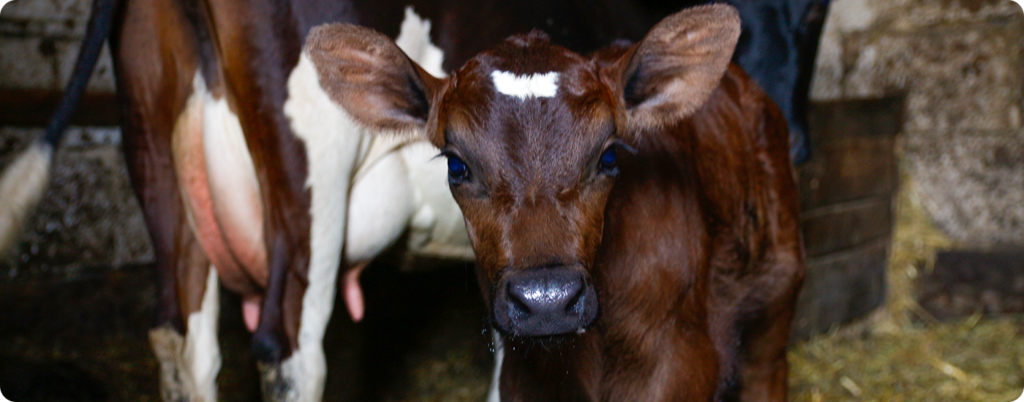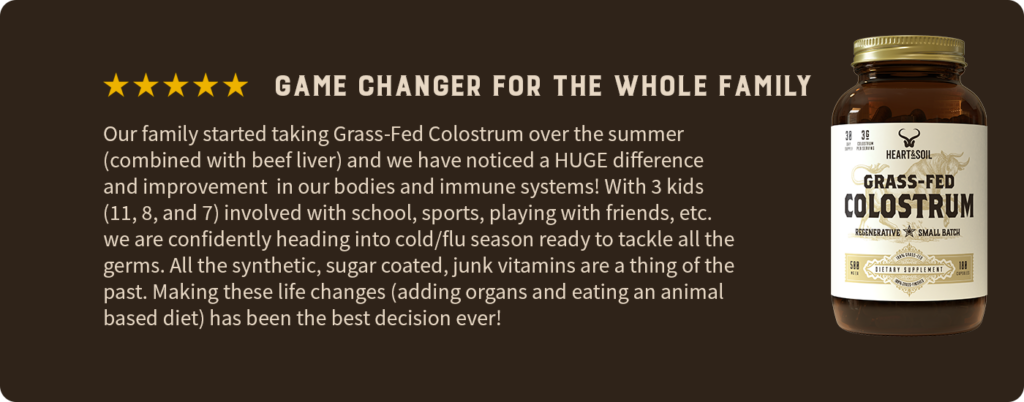PLEASE NOTE: The information in this blog is for educational purposes only. It is not a substitute for professional medical advice. Consult your healthcare provider if you’re seeking medical advice, diagnoses, or treatment.
Dairy has been used for thousands of years and is essential for human health and development (1). Milk products are a strong source of calcium and other nutrients with high bioavailability.
Despite this, many people avoid dairy products entirely or opt for non-dairy alternatives.
This article will outline the benefits of a powerful yet often overlooked component of dairy: colostrum.
You’ll learn:
- What is colostrum?
- How it differs from other forms of dairy.
- Six potential benefits of colostrum.
- Where to find colostrum and what to look for when buying it.
Let’s take a closer look!
What is Colostrum?
Colostrum is milk produced following birth (usually within the first 48 hours). It contains multiple nutrients, growth factors and peptides, and plays an indispensable role in fortifying the immune system amidst viral or bacterial assault.
Calves are prone to infection if they do not receive colostrum immediately after birth. Without it, they’re also at a higher risk of morbidity and mortality (2).

However, its benefits are not restricted to cattle. Newborn mammals require colostrum to enhance physiological processes like immunity, gastrointestinal development, and resistance to microbial infections (3).
Colostrum has been used for centuries to fend off illness and cultivate well-being. Before the development of antibiotics, colostrum was incorporated due to its antibiotic properties (4).
Colostrum is very similar to mature milk (made around 10-15 days after birth), but there are a few key differences (5):
- Colostrum is higher in protein and fat but has substantially less lactose.
- Colostrum contains higher concentrations of vitamins A, B, C, D, and K.
- Colostrum has more lactoferrin, which is powerful for muscle growth and healing. Lactoferrin also has antibacterial, antiparasitic, and antifungal properties.
Both mature milk and colostrum are rich sources of macronutrients and minerals like calcium, zinc, copper, magnesium, and phosphorus.
The term superfood gets thrown around often, but when it comes to nutrient density, colostrum is a true superfood!
6 Amazing Benefits of Grass-Fed Colostrum
We’ve seen colostrum have an incredible impact on individuals suffering from gut and immune issues as well as those looking to boost recovery and repair muscles and connective tissue.
Given the nutrient density of colostrum, it can have positive effects throughout your body.
1. Gut Health
Bovine colostrum supplementation can help maintain gastrointestinal integrity and permeability (6).

Colostrum has also shown therapeutic potential for GI conditions like inflammatory bowel disease (IBD) or NSAID gut injury (7). The presence of nutrients, growth factors, and hormones may contribute to the healing properties of colostrum against these challenges (8).
The maturity and growth of the infant GI tract can be significantly impacted by colostrum (9).
2. Immune System Support
Compared to placebo, bovine colostrum was shown to reduce nasal allergy symptoms (10). Colostrum’s antimicrobial activity can inhibit the growth of yeasts, bacteria, and viruses (11).
Several studies also showed that colostrum can be more effective at preventing the flu than vaccination (12, 13). It’s worth noting that both of these studies are epidemiological, meaning they can only suggest correlation (not causation).
As Sara and her family discovered, colostrum can be your ally during flu season!

3. Bone & Joint Health
Colostrum contains the protein lactoferrin, which increases the proliferation of cells vital for bone formation (14). Animal milk also contains exosomes, which play an important role in cell communication and can affect bone formation (15, 16).
The fat-soluble vitamins (A, D, E, K) found in colostrum may play a role in bone growth (17).
Not to mention, calcium is required for bone health at all stages of life (18). 100 grams of colostrum has about 1000mg of calcium (19). For the typical 19-70 year old (male or female), the recommended dietary allowance for calcium is 1000mg per day (20).
4. Neural Health
Lipids like gangliosides in colostrum boost neural development, and the growth factors (such as betacellulin) promote stem cell proliferation and stimulate neurogenesis (the formation of neurons)(21, 22).
Gangliosides are particularly important during infancy, when the brain is developing. The presence of gangliosides is highest in colostrum and declines throughout the transition to mature milk.
5. Athletic Performance & Recovery
Colostrum supplementation can help enhance recovery following intense exercise.
It may also help prevent gut permeability from exercise (23). One study on older adults even showed that combining colostrum supplementation and resistance training can increase leg press strength (24).
6. Skin Healing
The connection between colostrum and the skin has received less attention than other areas. But colostrum has still been shown to impact human skin positively!
Several studies have shown that colostrum can enhance wound healing (25, 26).
A study from 2022 concluded that exosomes from colostrum are a potential therapeutic agent to repair skin damage and aging (27).
Where to Find Colostrum
If you’re lucky, your local farmer will sell colostrum by special request. We always suggest going with fresh options if you can!
Not all colostrum is created equal. The quality of the colostrum is impacted by the health and diet of the animal, genetics, processing techniques, and other factors. Freeze and spray drying are recognized as methods that result in minimum loss of bioactive contents (28).
If you can’t find it locally, our Grass-Fed Colostrum contains 3,000 mg of colostrum.
There isn’t a standard dosage for colostrum, but studies find benefits from 500-2000mg per day (29). It is flash-pasteurized and spray-dried under optimized conditions and low temperatures (68–72 °C) to ensure purity, quality, and efficacy.
This process removes nearly all the moisture originally found in this product, eliminating the environment for any microbes (bacteria, viruses, parasites, etc.) to survive while preserving essential nutrition.
Our colostrum comes from grass-fed, regeneratively raised cows in New Zealand that spend their lives grazing on vast pastures.
These animals are not given antibiotics, hormones, or GMO feed. The ranchers we partner with do not use glyphosate. We also rigorously test all our products for heavy metals and other contaminants.
You can contact our team if you’d like more details!
Digging Deeper: Colostrum FAQs
What about the baby calves?
We ensure that the calf’s needs are met before harvesting the colostrum for our product. This usually happens 72 hours after the calf has been born.
Cows produce large amounts of colostrum—far more than enough for the calf to start their lives with robust health. Plus, it would be a very poor business move for a farmer not to allow a calf to get all the colostrum it needs to thrive.
Can I take colostrum if I’m an athlete?
It depends. While colostrum can positively impact athletic performance, IGF-1 is banned by the NCAA, and this is found in colostrum.
All of our products (minus Whole Package, due to the presence of testosterone in bull testicles) passed Informed Sports standards.
Grass-Fed Colostrum did not receive the certification (even though it met the standards) because it contains a substance banned by the NCAA (30). This blog post walks through our products and the Informed-Sport Certification.
So, NCAA and other drug-tested athletes should not take Grass-Fed Colostrum.
Does colostrum contain dairy?
Colostrum contains dairy; however, our Grass-Fed Colostrum is low in lactose, which is generally the most problematic compound in dairy products (31).
Colostrum is high in casein protein, so you must be careful if you are sensitive to casein.
Where can I learn more about colostrum?
The Institute of Colostrum Research is a fantastic tool to learn more about colostrum. Their site contains various articles, studies, and relevant information surrounding colostrum.
Colostrum is a Superfood
Humans have used colostrum for centuries as it’s incredibly nutrient-dense and has antibacterial, antibiotic, and antiviral properties. It differs from other forms of dairy in that it’s a richer source of macronutrients and components like lactoferrin.
Colostrum can work wonders for your immune system, brain, gut, skin, and bones!
Reach out to a local farmer and try to get your hands on fresh colostrum, or check out our Grass-Fed Colostrum.
Subscribe to future articles like this: